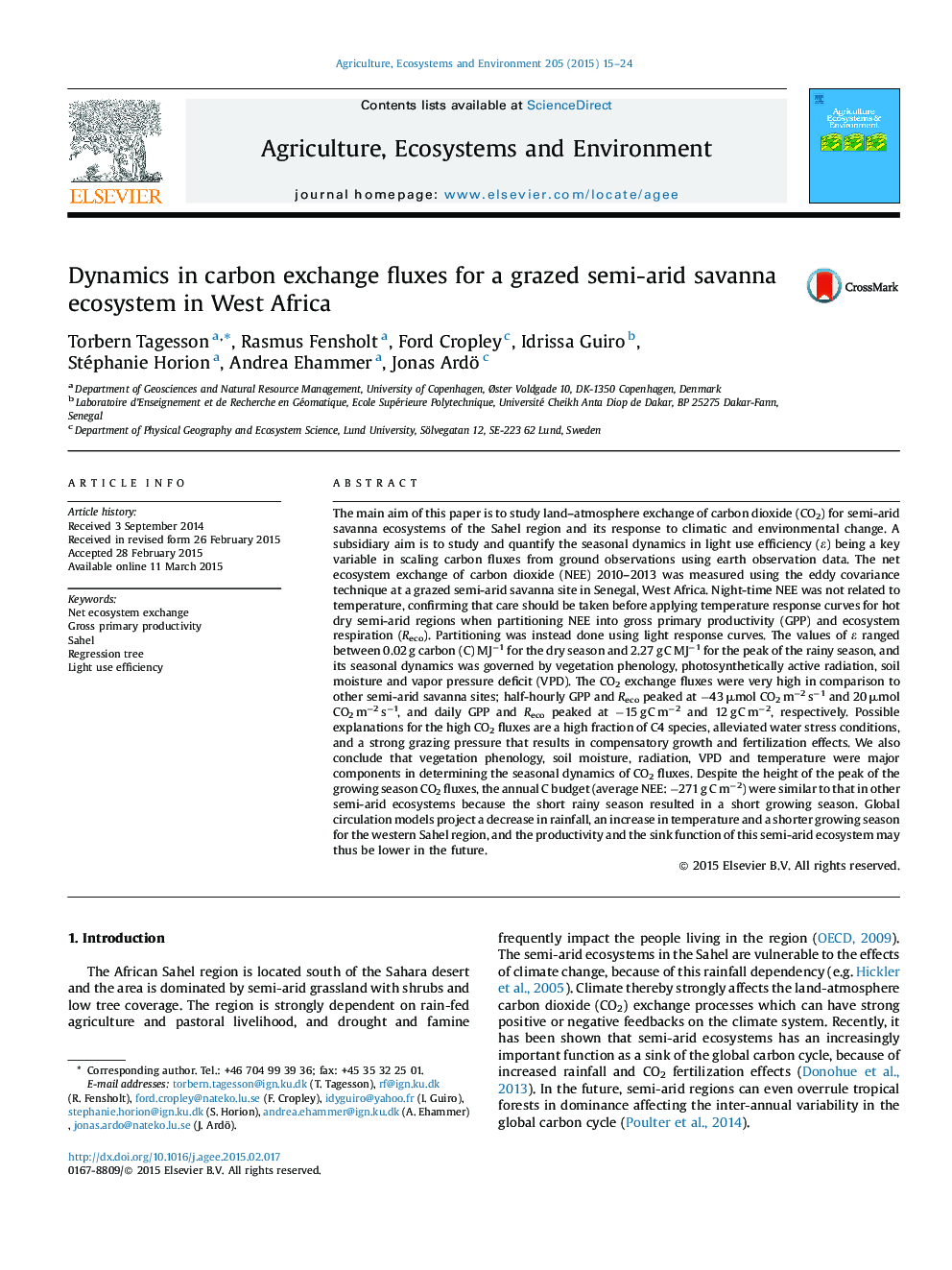| کد مقاله | کد نشریه | سال انتشار | مقاله انگلیسی | نسخه تمام متن |
|---|---|---|---|---|
| 8487741 | 1552047 | 2015 | 10 صفحه PDF | دانلود رایگان |
عنوان انگلیسی مقاله ISI
Dynamics in carbon exchange fluxes for a grazed semi-arid savanna ecosystem in West Africa
ترجمه فارسی عنوان
دینامیک جریان شبیه سازی کربن برای یک اکوسیستم نیمه خشک ساوانا در غرب آفریقا
دانلود مقاله + سفارش ترجمه
دانلود مقاله ISI انگلیسی
رایگان برای ایرانیان
کلمات کلیدی
تبادل اکوسیستم خالص تولید ناخالص اولیه، ساحل، درخت رگرسیون، بهره وری استفاده از نور،
موضوعات مرتبط
علوم زیستی و بیوفناوری
علوم کشاورزی و بیولوژیک
علوم زراعت و اصلاح نباتات
چکیده انگلیسی
The main aim of this paper is to study land-atmosphere exchange of carbon dioxide (CO2) for semi-arid savanna ecosystems of the Sahel region and its response to climatic and environmental change. A subsidiary aim is to study and quantify the seasonal dynamics in light use efficiency (ϵ) being a key variable in scaling carbon fluxes from ground observations using earth observation data. The net ecosystem exchange of carbon dioxide (NEE) 2010-2013 was measured using the eddy covariance technique at a grazed semi-arid savanna site in Senegal, West Africa. Night-time NEE was not related to temperature, confirming that care should be taken before applying temperature response curves for hot dry semi-arid regions when partitioning NEE into gross primary productivity (GPP) and ecosystem respiration (Reco). Partitioning was instead done using light response curves. The values of ϵ ranged between 0.02 g carbon (C) MJâ1 for the dry season and 2.27 g C MJâ1 for the peak of the rainy season, and its seasonal dynamics was governed by vegetation phenology, photosynthetically active radiation, soil moisture and vapor pressure deficit (VPD). The CO2 exchange fluxes were very high in comparison to other semi-arid savanna sites; half-hourly GPP and Reco peaked at â43 μmol CO2 mâ2 sâ1 and 20 μmol CO2 mâ2 sâ1, and daily GPP and Reco peaked at â15 g C mâ2 and 12 g C mâ2, respectively. Possible explanations for the high CO2 fluxes are a high fraction of C4 species, alleviated water stress conditions, and a strong grazing pressure that results in compensatory growth and fertilization effects. We also conclude that vegetation phenology, soil moisture, radiation, VPD and temperature were major components in determining the seasonal dynamics of CO2 fluxes. Despite the height of the peak of the growing season CO2 fluxes, the annual C budget (average NEE: â271 g C mâ2) were similar to that in other semi-arid ecosystems because the short rainy season resulted in a short growing season. Global circulation models project a decrease in rainfall, an increase in temperature and a shorter growing season for the western Sahel region, and the productivity and the sink function of this semi-arid ecosystem may thus be lower in the future.
ناشر
Database: Elsevier - ScienceDirect (ساینس دایرکت)
Journal: Agriculture, Ecosystems & Environment - Volume 205, 1 July 2015, Pages 15-24
Journal: Agriculture, Ecosystems & Environment - Volume 205, 1 July 2015, Pages 15-24
نویسندگان
Torbern Tagesson, Rasmus Fensholt, Ford Cropley, Idrissa Guiro, Stéphanie Horion, Andrea Ehammer, Jonas Ardö,
